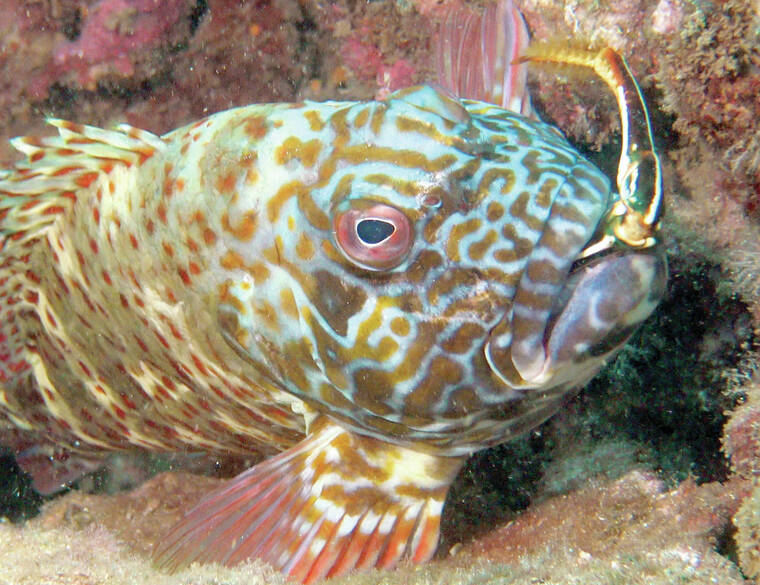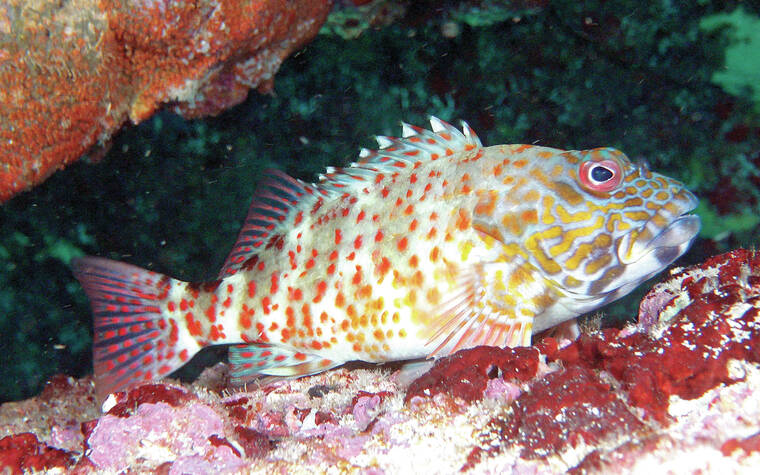Po‘opa‘a the foot long stocky hawkfish is a master at hunting on the Hawaiian shallow coral reefs. Local fishermen call it a rockfish, as it sits up on top of rock piles and coral heads where it uses its pectoral fins like hands as it stabilizes itself in the surge caused by the surf.
Po‘opa‘a means “hard head” and these small but powerful fish eat just about anything that moves. Their green, yellow, red and white blotched colors make them blend into the reef background and they will remain motionless for hours waiting for a meal to come close enough for it to gulp it down.
Divers and snorkelers often see this fish sitting on the reef and po‘opa‘a has developed a hunting technique by following divers around hoping that they scare up small fish and crabs off the reef then the hawkfish zooms in to grab its meal.
Sometimes, while scuba diving, I will stop and look around and see four or five of the stocky hawkfish just watching me go by, hoping for a free meal.
When divers spearfish the po‘opa‘a will come from all over the reef when they hear the sound of a speargun, as they know all the activity will scare small fish off the reef that they can easily catch. We think the hawfish have learned to follow divers because they do the same with monk seals and us humans look very much like a seal in the eyes of our local marine life.
When I scuba dive, I often see the stocky hawkfish sitting very still in the mouth of a cave or crack in the reef. Often I will see lobsters in the cave right behind the hawkfish and they don‘t seem to be scared because the hawkfish is way too small to eat them.
Po‘opa‘a will get very excited when I reach into a cave and pull out a lobster with my hands even though the lobster is way bigger than the fish. I had one hawkfish that greeted me every time I dove near the mouth of a big cave and it would follow me around when I explored the cave with my bright dive lights on.
One day I found a big lobster in the cave and grabbed it. As soon as I had it firmly in my hands, the stocky hawkfish zoomed in and bit off one of the lobsters legs. Since I had my camera on. I shot a video of this 8-inch long fish trying to swallow a lobster leg that was as long as the fish was.
Often out on the coral reef one fish species will follow a larger predator fish so it can share in the catch when the larger predator hunts. Reefs that often have scuba divers on a regular basis, the fish have learned that they can follow us around so they can get an easy meal when we scare up small fish.
Humans have become part of the entire food chain at well known dive sites and often there will be more fish at the dive site then on surrounding reefs because the fish know we will help them get an easy meal.
You can see po‘opa‘a in action in my movie Marine Life At Sharks Cove up on my underwater educational webpage at www.underwater2web.com.
•••
Terry Lilley is a marine biologist living in Hanalei Kaua‘i and co-founder of Reef Guardians Hawai‘i, a nonprofit on a mission to provide education and resources to protect the coral reef. To donate to Reef Guardians Hawaii go to www.reefguardianshawaii.org.




